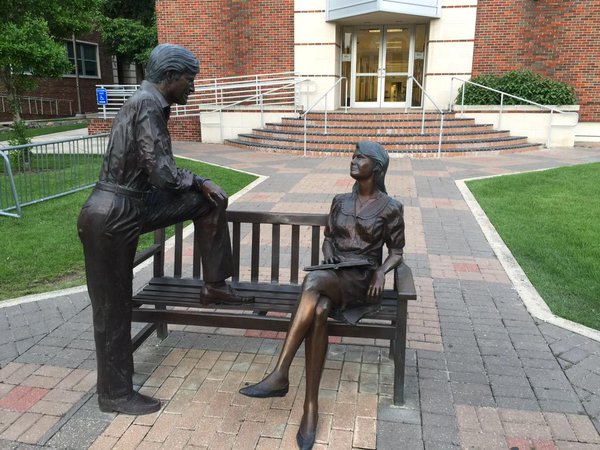
“#Mansplaining**. The Statue” Picture Source
I put down a bunch of words about gender and race over at Identity, Education, and Power and got to join and have lots of really interesting and challenging conversations. I’m hoping they continue in all sorts of spaces.
The upside of writing the piece is that I got to talk to lots of smart women about a matter of life and death we’re not used to talking about. The downside? It primed me to see patterns. In the piece, I cited a text by Soraya Chemaly about the history of girls outperforming boys in schools that has really stuck with me. The entire text is full of great stuff. Including this quote:
What if we stopped calling it a boy crisis, and started talking about male OVERconfidence?
So while I may feel a certain envy at the confidence and hubris exhibited by a particular man or men when they talk about a topic they may not be well-versed in – that’s on me and my lizard brain and ego. It’s better to look at patterns, as it is with most things related to sociology.
Evidence for the claim 1: Code designed by women rated higher than men’s, but rejected when gender revealed
Evidence for the claim 2: The remarkably different answers men and women give when asked who’s the smartest in the class
Evidence for the claim 3: Why men get all the credit when they work with women
Evidence for the claim 4: Everything tagged “Knowledge and Intelligence” on the Sociological Images blog.
Evidence for the claim 5: The entire book Men Explain Things to Me.
Evidence for the claim 6 (added March, 2016): That this piece on ed tech was given national exposure over anything by Audrey Watters, who has been saying the same thing for YEARS.
So … now what? In my Identity post, I advocate for white female teachers to leverage the power of demographics to transform how race and gender are addressed and taught in schools. If numbers mean power, then white women hold some degree of power in schools. I think we can bring about massive change, combining cognitive shifts at the individual level with large-scale re-framing of this thing we call “school.”
At the same time, I’m reminded of a rather disconcerting reality: American women did not get the right to vote – the all-male Congress of 1920 had to give it. The men had to progress enough in their own views of women to recognize the right to vote wasn’t gender-specific (or at least fake that awareness because it was more politically savvy.) In so many cases and spheres even today, change will require massive shifts to the mental models held by men.
How do we reconcile these things? How do we bring about change in an arena where we do not hold power or hold very little? How do we change men’s mental models when our formative years were marked by boys hearing girls should demur and defer and girls seeing teachers excuse male classmates’ behaviors under the heading of “boys will be boys”? Just as most white Americans were likely raised to *not* talk about race, I suspect most men were raised not thinking about gender in any real sense. Add in tensions around heteronormative behavior and it appears as if nothing is going to change without some serious recombobulation. And to be clear, it’s #notallmen. There is a marked difference in exchanges with men who aren’t wearing a mantle of confidence or a cape of mentorship.
So how do we help individual men see the patterns in their behaviors? What does it look like to change the system, one mindset at a time?
I honestly don’t know what an individual woman is supposed to do. I know (because I’ve been told) it’s not my job to explain to an individual man when I see the pattern – cause that’s rude and annoying. And hand upon a stack of first-edition feminist lit books, I’m all ears to any man who wants to explain it to me. But be forewarned, if your solution relies on women changing our behavior, I’ll say that’s all well and good – but tell me again how it was that women got the right to vote?
*Below is one of my most favorite pictures ever on Twitter. From the single headphone cord, to the quote, to the framing of the shot – I love it and I want to do everything in my power to get her voice heard and knock down what I can that’s between her and the freedom she’s entitled to and wants. I’m going to use this asterisk as a way to share this picture and to clarify that the pattern of over-confidence, while not limited to white men, is unique in its manifestations among white men. Sociological Images has some great tags that compile texts on how the messages about men of color are different than those sent about white men. There’s also some compelling work from those who study stereotype threat that gets at how few white male archetypes and stereotypes exist.
#GetInFormation #BlackGirlRising #AssataShakur pic.twitter.com/aCi6ZMOO3a
— Young People of Color Inc. (@YoungPplofColor) February 16, 2016
**Mansplaining is a flawed term, I get that. If the Germans have a better word for it, I’ll start using that word.





